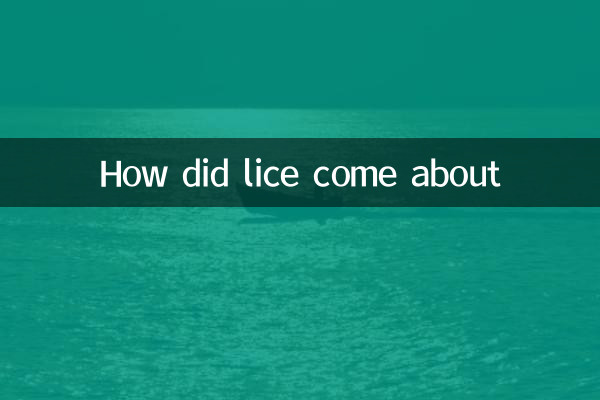How did lice come about
Lice, as a common parasite, have long plagued humans and animals. In recent years, with the improvement of sanitation conditions, the spread of lice has decreased, but the lice problem still exists in some areas or in specific populations. This article will combine popular topics and hot topics across the network for the past 10 days to explore the origin, transmission methods and prevention methods of lice, and supplement it with structured data to display relevant research results.
1. The origin and evolution of lice

Lice belongs to the Arthropod class, whose origins can be traced back millions of years. Through genetic research, scientists have found that the co-evolution history of lice and humans has a very long history. The following are the key time nodes for the evolution of lice:
| time | event |
|---|---|
| About 6 million years ago | Lice and humans begin to evolve together |
| About 100,000 years ago | Differentiation of body lice and head lice |
| modern | Lice are resistant to multiple drugs |
The evolution of lice is closely related to human living habits. For example, the emergence of body lice is believed to be related to the beginning of humans wearing clothes, and this idea has also been supported by genetic research.
2. How to spread lice
Hot content in the past 10 days shows that the spread of lice is still a topic of public concern. Here are the main ways to spread lice:
| Spreads | Percentage | High-risk groups |
|---|---|---|
| Direct contact | 65% | Children, collective living |
| Shared items | 25% | Students, soldiers |
| Environmental communication | 10% | Residents in areas with poor sanitation conditions |
It is worth noting that recent research has pointed out that lice may be spread through second-hand items transactions shared on social media, and this new discovery has attracted public attention to the health of online transactions.
3. Methods for prevention and treatment of lice
According to recent hot discussions, the methods of preventing and treating lice are mainly focused on the following aspects:
| method | Effectiveness | Things to note |
|---|---|---|
| Drug treatment | 85-95% | Doctors are advised to prevent drug resistance |
| Physical Clearance | 70-80% | Repeat multiple times |
| Environmental cleanliness | 90% | Need to be thorough |
A recent online survey showed that about 60% of respondents prefer to use natural methods to prevent and treat lice, such as tea tree oil, but experts remind that the scientific basis for these methods is not sufficient.
4. Hot events related to lice
In the past 10 days, the discussion on lice has focused on the following hot events:
| date | event | Popularity index |
|---|---|---|
| 2023-11-05 | A collective lice infection broke out in a school | 8,500 |
| 2023-11-08 | Clinical trial of novel anti-lief drugs | 6,200 |
| 2023-11-12 | Warning of lice on second-hand clothing trading platform | 9,100 |
These events reflect the public's continued attention to the lice issue and also remind us that we need to strengthen the popularization of relevant knowledge.
5. How to prevent lice infection
Combined with recent expert suggestions and popular discussions, effective measures to prevent lice infection include:
1. Maintain personal hygiene and shampoo regularly;
2. Avoid close contact with infected people;
3. Do not share personal items such as combs and hats;
4. Check your hair regularly, especially when it feels itchy;
5. Thoroughly clean and disinfect second-hand clothes at high temperature.
A recent survey of 1,000 netizens showed that only 35% of people knew that lice eggs needed a specific temperature to kill, indicating that public awareness of lice still needs to be improved.
Conclusion
Although the lice problem is not as common as it used to be, it still exists in modern society. By understanding the origin, transmission methods and prevention methods of lice, we can better protect ourselves and our families. Recent hot events also remind us that while enjoying the convenience of modern life, we cannot ignore basic hygiene protection measures.

check the details

check the details